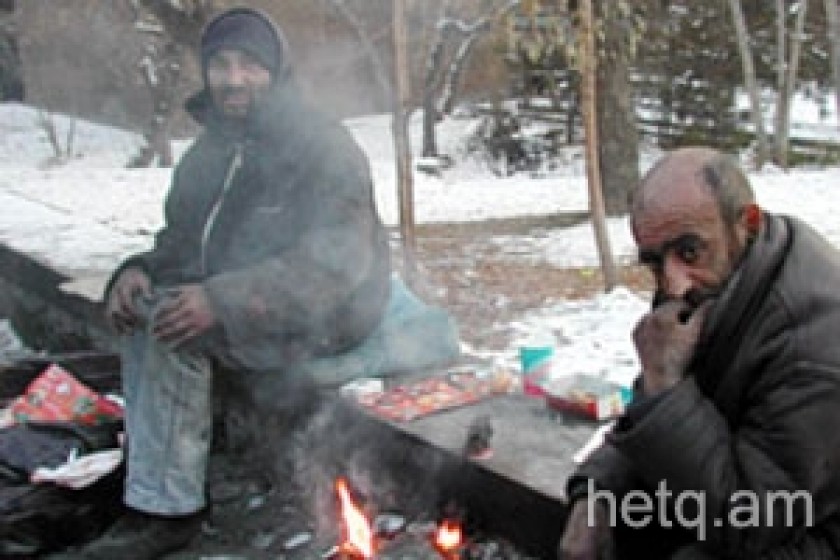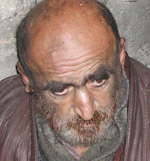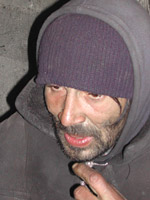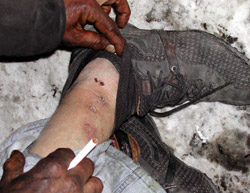
The Homeless People of the Chamber Music Hall
Vahe Sarukhanyan
Ararat Davtyan
Two men were getting ready for dinner by the dumpster near the Chamber Music Hall.
One of them was warming his frozen fingers by the fire, and the other was inspecting the content of a plastic bag and taking out what they needed: pieces of fried potato, scraps of meat and bone, bread. The man who was looking through the bag was about 40 years old. He was tall and handsome. The other looked older and feebler.
The name of the first man was Tony, and the other Myasnik. As soon as they learned that we were journalists and wanted to help them, Tony asked us in a mix of Armenian and Russian, “Do you have ... a cigarette ... to smoke?” We offered them a pack of cigarettes.
Tony refused to take the cigarette when he saw that what we offered were more expensive than the Chibukh he had expected. Then he took one, looked at the box and said happily “Look, Myasnik, when was the last time you smoked a cigarette like this?” His friend smiled in response.
 Myasnik spoke with great difficulty. He had suffered damage to his nervous system in the past, and had had an attack of his recurrent epilepsy four days prior to our conversation.
Myasnik spoke with great difficulty. He had suffered damage to his nervous system in the past, and had had an attack of his recurrent epilepsy four days prior to our conversation.
We understood the following from his scanty story.
49 year-old Myasnik Mikaelyan has been homeless for six years. His wife lives with their teenage daughter and son onKomitas Street. Myasnik wound up on the street after they sold their previous apartment and his wife turned him out.
Russian-speaking Tony, a Serb, served as a translator between Myasnik and us.
 As Tony told his own story, he had been a micro-surgeon. He met Alvard Harutyunyan inMoscow several years ago. She was a physician, too. They married and moved toNorway and opened their own clinic. Then his wife suggested they move toArmenia. They lived first in the home of his mother-in-law in the Zeytun District and then moved toMashtots Avenue. However his wife sold their apartment and their car, left the children with her mother, took all their money, and left forNorway.
As Tony told his own story, he had been a micro-surgeon. He met Alvard Harutyunyan inMoscow several years ago. She was a physician, too. They married and moved toNorway and opened their own clinic. Then his wife suggested they move toArmenia. They lived first in the home of his mother-in-law in the Zeytun District and then moved toMashtots Avenue. However his wife sold their apartment and their car, left the children with her mother, took all their money, and left forNorway.
Tony explained that everything had been registered on his wife's name, and she had swindled him.
Tony became acquainted with Korean Klara Von Den Yun soon after he found himself on the streets. Her mother was Armenian. Klara also was a vagrant. They stayed together for a year.
“I want to work, I don't want to live like a bum, but look at my wounds. How can I work with them?” Tony asked, showing the wounds on his hands and feet. Then he added, “I know I'm going to die...”
The former doctor said that he had worked illegally in theErebuniHospitalsoon after he found himself on the streets, but then had been asked to pay a bribe of 1,400 dollars.
 “You have everything inArmeniaif you have money, and you'd be better off dead if you don't. Even the emergency medical service does nothing free of charge. We took my wife Klara to the hospital when she broke her leg. The next day they brought her back and set her down in the Shrjanayin area where they found her,” Tony said.
“You have everything inArmeniaif you have money, and you'd be better off dead if you don't. Even the emergency medical service does nothing free of charge. We took my wife Klara to the hospital when she broke her leg. The next day they brought her back and set her down in the Shrjanayin area where they found her,” Tony said.
Tony was able to have his wife admitted to the homeless shelter inYerevan'sFourthVillage.
“I sent my wife there since there was no other way out. But I won't go. I'd rather die in the street,” Tony said. He remembered the brutality of two former guards at the shelter, now dismissed, Ashot and Gevorg, and said, “The eye is afraid of what it has seen.”
“I am homeless and I am happy. What's better, to be a tramp or a criminal? I am a tramp and my soul is at peace,” Toni said emphatically.
Toni suggested showing his dwelling – the bunker. But he hesitated a moment and said, “Hold on to these plastic bags so no one steals them.”
 “Who would do that?” we asked.
“Who would do that?” we asked.
“There are so many homeless people,” he answered.
The bunker was located adjacent to the police office building.
“It's good that the police don't disturb us,” said Tony, and explained that it was good to be near the police as it would be possible to ask them for help if needed.
There was a gazebo in the courtyard of the building near the bunker. Tony describes in detail how the frozen body of Gayane, or Mama, as he called the 47-year-old woman, had been found there two or three days before. The apples were still on the gazebo table. Gayane's shawl had fallen on the ground...
The place called a bunker was a basement that housed the water supply valves were placed. Tony and Myasnik spent nights there.
 We had bought candles at Toni's request. He lit them in the bunker and exclaimed like a child, “Myasnik look, we have a candle ... a candle. Now we will have light.” The two tramps hugged and kissed each other.
We had bought candles at Toni's request. He lit them in the bunker and exclaimed like a child, “Myasnik look, we have a candle ... a candle. Now we will have light.” The two tramps hugged and kissed each other.
The floor of the bunker floor was covered in garbage – plastic bottles, plastic bags, articles of clothing, and even toys.
Toni told us about Sima. Sima was a rat that lived in the bunker.
“She brings us bread. She brought lavash, put it on my chest and went away several days ago. Sima is nice, but a little crazy. She doesn't let us to sleep at night,” Tony told excitedly.
We went back to the dumpster .
“Myas, they're still there. Nobody took them ... ha ha,” he exclaimed happily when he saw that no one had approached their plastic bags.
 Videos
Videos Photos
Photos




Write a comment